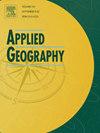山地景观声景观的时空格局映射
IF 5.4
2区 地球科学
Q1 GEOGRAPHY
引用次数: 0
摘要
我们对声景与人类福祉之间关系的理解不断增加,强调了声景管理的必要性。为了有效地提高声景质量,需要了解声景特征的时空格局。本研究综合了巴伐利亚阿尔卑斯(德国)复杂山地景观的声景观特征的时空格局,将音频记录(n = 41)沿海拔和人类活动梯度的定量分析与通过参与式测绘调查收集的人类对声景观质量的感知(n = 47,不愉快:n = 44)相结合。通过对主要声源的声音清查,我们的研究结果表明,采样点的声景观是由多个声源组成的,但以空中交通、道路交通、鸟类和昆虫为主,并遵循昼夜活动周期。声源的空间格局、声学指数和感知声景观质量受到人类基础设施(如道路、缆车)、人类活动(如农业、旅游业)、地形和土地覆盖的显著影响。虽然人声、生物声和地质声没有显示出明确的空间模式,但基于森林的回归模型(解释了高达62%的方差)预测,技术声集中在谷底和邻近的山坡上,强调了技术声对声景感知的影响。我们的发现为景观和声景特征之间的关系提供了支持声景管理的见解。本文章由计算机程序翻译,如有差异,请以英文原文为准。
Mapping spatio-temporal patterns of soundscapes in a mountain landscape
Our understanding of the relationships between soundscapes and human well-being is continuously increasing, emphasizing the need for soundscape management. To effectively improve soundscape quality, knowledge on spatio-temporal patterns of soundscape characteristics is required. This study comprehensively assessed and mapped spatio-temporal patterns of soundscape characteristics in a complex mountain landscape in the Bavarian Alps (Germany), integrating quantitative analyses of audio recordings (n = 41) along gradients of elevation and human activity with human perception on soundscape quality gathered through a participatory mapping survey (pleasant: n = 47, unpleasant: n = 44). Based on an aural inventory to identify major sound sources, our results indicate that soundscapes at the sampling sites were composed by multiple sound sources, though dominated by air traffic, road traffic, birds, and insects, following diurnal cycles of activity. Spatial patterns of sound sources, acoustic indices, and perceived soundscape quality were significantly influenced by human infrastructure (e.g. roads, cable cars), human activity (e.g., agriculture, tourism), topography, and land cover. While anthrophony, biophony, and geophony did not show clear spatial patterns, the forest-based regression model, explaining up to 62 % of the variance, predicted a concentration of technophony on the valley bottom and adjacent hillslopes, emphasizing the impact of technophony on soundscape perceptions. Our findings provide insights into the relationships between landscape and soundscape characteristics supporting soundscape management.
求助全文
通过发布文献求助,成功后即可免费获取论文全文。
去求助
来源期刊

Applied Geography
GEOGRAPHY-
CiteScore
8.00
自引率
2.00%
发文量
134
期刊介绍:
Applied Geography is a journal devoted to the publication of research which utilizes geographic approaches (human, physical, nature-society and GIScience) to resolve human problems that have a spatial dimension. These problems may be related to the assessment, management and allocation of the world physical and/or human resources. The underlying rationale of the journal is that only through a clear understanding of the relevant societal, physical, and coupled natural-humans systems can we resolve such problems. Papers are invited on any theme involving the application of geographical theory and methodology in the resolution of human problems.
 求助内容:
求助内容: 应助结果提醒方式:
应助结果提醒方式:


